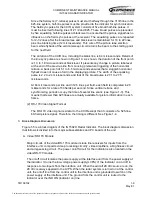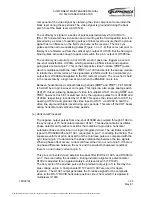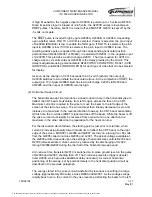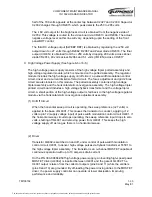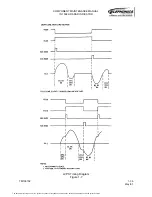
COMPONENT MAINTENANCE MANUAL
IN 1502H RADAR INDICATOR
TM109102
1-21
May/01
input signal. In such a case, the red output would float 65 volts (-0501) or +53
volts (-0503, -0504) through R1035 and R1036, keeping the gun off.
MOSFET Q1008 switches to +65 volts (-0501) or +53 volts (-0503, -0504) to turn off
the red gun. Q1009 switches to the level set by R1047 to turn on the gun. This level is
set by voltage-to-voltage converter U1018C and U1018D and depends upon the
voltage on the wiper of potentiometer R1047. As mentioned, the green video amplifier
is fixed to switch to ground to turn on the green gun. This level provides a reference
for adjusting the blue and red video amplifiers, which can be set anywhere between
-11 and +16 volts, to allow balancing of the three guns. A perfect balance provides
pure white on the screen when all three guns are on.
(5) Degaussing Circuit
The degaussing circuit generates a decaying magnetic field around the CRT at 2
second to 3 second intervals to neutralize the magnetism that otherwise could build
up around the picture tube. The circuit consists of timer U1010, triac Q1025,
comparator U1002D, transistor Q1024, and associated components.
Capacitor C1072 charges 250 volts through R1143. This voltage is applied
across the degaussing coil, which encircles the CRT near the faceplate. The capacitor
is rapidly discharged to ground through the degaussing coil and triac Q1025 every two
to three seconds, triggering a high-frequency damped oscillation that decays in about
250 microseconds.
The loop formed by Zener diode CR1011, comparator U1002D, transistor Q1024 and
timer U1010 controls the firing of triac Q1025 and ensures that degaussing occurs
only during the Y-retrace, when no video is being written on the screen.
As C1072 charges 250 volts, it reaches the breakdown voltage level of Zener
diode CR1011 (about 205 volts). When CR1011 conducts, it drops about 200 volts
and applies 5 volts to the positive input of comparator U1002D. The negative input of
the comparator is biased at +2.8 volts, which keeps its output negative except when
CR1011 conducts. Thus, PNP transistor Q1024 conducts most of the time, disabling
U1010 by holding its trigger input (pin 2) at +5 volts.
When CR1011 conducts, however, the output of the comparator is driven positive to
switch off Q1024. The collector of Q1024 is at +5 volts until the next Y-retrace (YRET)
pulse pulls it low via R1107.
Timer circuit U1010 is configured as a one-shot multivibrator. It is triggered by the
negative-going edge of the YRET pulse applied at pin 2, which produces a positive,
1-millisecond, output pulse at pin 3. This output fires triac Q1025 to rapidly discharge
C1072 through the degaussing coil. Peak current produced is around 10 amperes.
Oscillations die within 250 microseconds, well before the end of YRET (which has a
pulse width of over 500 microseconds).
(6) Brightness Circuit
The brightness circuit consists of operational amplifier U1017C, FET Q1010, PNP
transistor Q1013 and associated components. An additional component of the
The document reference is online, please check the correspondence between the online documentation and the printed version.



